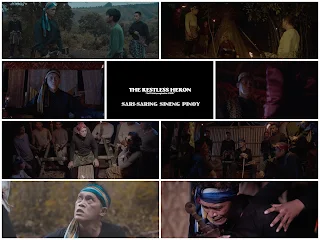The political landscape that seeps through Joel C. Lamangan's Lihis (Film Development Council of the Philippines, BG Films International, 2013) is as deep as the movie's heartbreaking story of two idealistic young men who fall in love almost by accident. It is embedded in this landscape where their idyll begins and ends. The same mood of acute desolation permeates Ricardo Lee's screenplay. Their intimacy just happens to unfold in ways that bring tragedy to the surface while keeping the viewer at a certain remove. What happens between Cesar (Jake Cuenca) and Ador (Joem Bascon) builds slowly, then explodes after which they retire to opposite corners. Their rough, impulsive coupling could have been a fight, it almost is. Lamangan filmed it with the frankness of a boxing match. Both Cuenca and Bascon make this anguished love story physically palpable. Cuenca disappears beneath the skin of his sinewy character. The pain and disappointment felt by Cesar, who is more self-aware and self-accepting continually registers in his sad, expectant eyes. Cesar is able to accept a little more willingly that he is inescapably gay. Lihis is ultimately not about sex (there is very little of it in the film) but about love, love stumbled into, love thwarted, love held sorrowfully. What Ador craved in a way he could neither help nor understand was when Cesar pulled him close, the silent embrace satisfying some shared hunger. One tender moment's reprieve from loneliness can illuminate a life.
In the end, this is Jake Cuenca’s picture, the final scenes allowed him to unequivocally and credibly express Cesar's sorrow. Joem Bascon plays the more callow of the two men, coincidentally or not, his performance doesn't dig as deep as you want it to. Lovi Poe as Cecilia whose youth and spiritedness slowly drain away in the face of an infidelity she can't encompass adds a beautiful low-rent weariness to the performances. The grading brings a sense of brilliance to the color spectrum, an accuracy and nuance that befits the film and the high definition format. It offers depth and tonal detail, natural greens delight, clothes pop and earthy tones around the frame enjoy a sense of pinpoint accuracy bringing the film to life. Bright outdoor scenes are delightful, the contrast between sun-drenched portions and shadowy elements are lifelike. Skin tones are perfect, black level is remarkable and whites are intense. The image is razor-sharp, bringing out refined details on faces and complex environments. The soundtrack delivers crisply defined support elements. Richly realized environmental atmospherics add bursts of heightened activity capable of handling its every core element with commendable ease, enriching scene-shaping and mood-enhancing clarity. Though it's mostly front heavy, dialogue is perfectly prioritized, positioned and detailed. Lihis is extraordinarily well done from a technical and emotional perspective, potential viewers must tread carefully.
Screenplay: Ricardo Lee
Director of Photography: Mo Zee
Editor: John Wong
Production Designer: Edgar Martin Littaua
Music: Von de Guzman
Sound: Mike Idioma
Direction: Joel C. Lamangan










